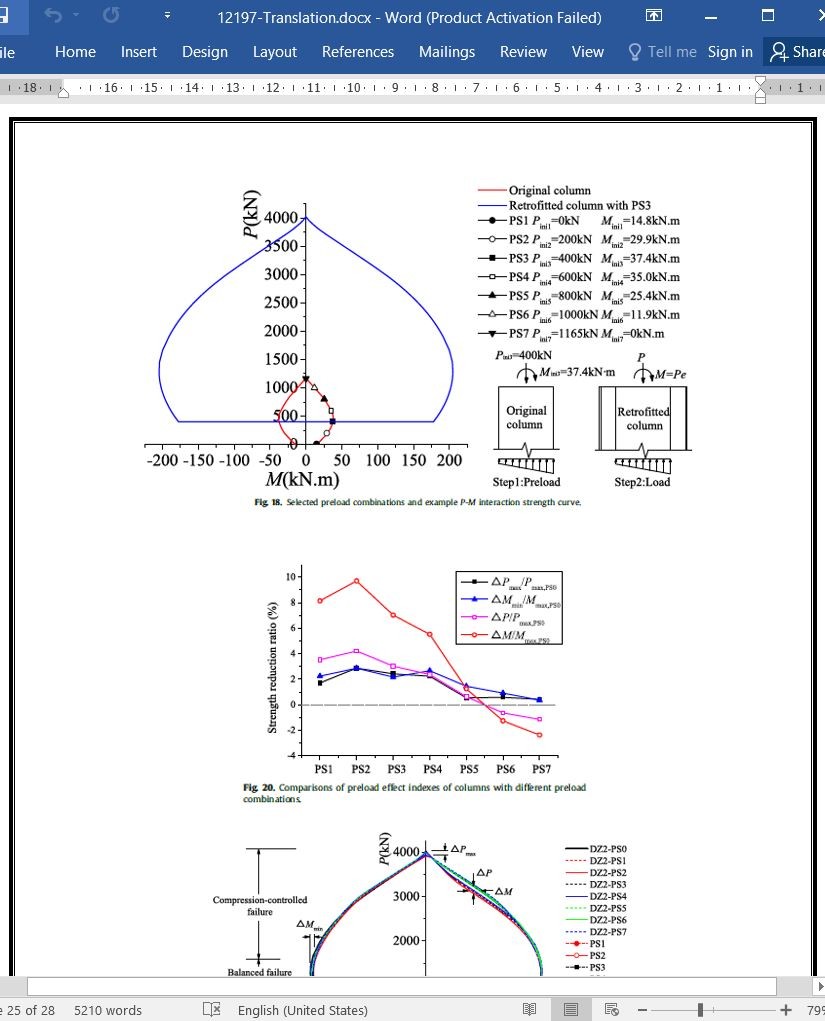
رفتار ستون های بتن آرمه تکمیل شده دارای پوشش فولادی با اثرات پیش بارگذاری مجدد
چکیده
ایجاد پوشش فولادی، راهی مؤثر برای تکمیل ستونهای بتنآرمه است. مطالعات قبلی بر بهبود عملکرد بدون در نظر گرفتن پیش بارگذاری روی ستونهای اصلی تمرکز داشتند. پیش بارگذاری ممکن است به ناچار بر عملکرد ساختاری ستونهای تکمیلشده تأثیر بگذارد. در این مقاله، مطالعات جامع آزمایشگاهی و عددی در مورد رفتار ستونهای RC تکمیلشده با فولاد جک با اثرات پیش بارگذاری ارائه شده است. همچنین 29 ستون دارای پوشش فولادی با ضخامت لولههای فولادی مختلف، سطوح پیش بارگذاری محوری و غیر هادی های بار، تحت بارگذاری فشاری متحرک یا غلطکی تحت آزمایش قرار می گیرند.
نتایج تجربی مورد بحث قرارگرفته و نشان داده شده است که اثرات سطوح پیش بارگذاری بر مقاومت فشاری محوری ستونهای تکمیلشده ناچیز است و درعینحال افزایش پیش بارها میتواند مقاومت فشاری خارج از مرکز را کاهش دهد. مدل عنصر فيبر براي پیشبینی رفتار ستونهای تکمیلشده، ایجادشده است. رفتار غیرخطی مواد تمام اجزای لوله فولادی و تقویتکننده اثرات شکلدهی بتن و همچنین اقدام پیش بارگذاری، در مدل، در نظر گرفتهشده است. مدل با مقایسه نتایج آن با نتایج تجربی تأیید شده است. مطالعات پارامتری گستردهای با استفاده از مدل عددی پیشنهادی برای توضیح اثرات پیش بارگذاری محوری و لحظهای و اثرات پیش بارگذاری با پارامترهای مختلف بر روی عملکرد ستونهای تکمیلشده انجام میشود.
6. نتیجهگیری
مطالعات تجربی و عددی بر روی رفتار ستونهای RC تکمیلشده با پوشش فولادی با اثرات پیش بارگذاری انجام شد. بیستونه ستون که بهوسیله پوشش فولادی تکمیلشده بودند از نظر بارگذاری فشردهشده خارج یا داخل مرکز مورد آزمایش قرار گرفتند. نتایج آزمایش نشان داد که اثرات پیش بار محوری بر مقاومت فشاری محوری ستونهای تکمیلشده ناچیز است. این مشاهدات با نتایج بهدستآمده توسط تاکئوتی و همکارانش [12] در مورد ستونهای بتونی تکمیلشده مطابقت دارد. مقاومت فشاری بیرونی ستونها پس از پیش بارگذاری کاهش مییابد، اما اثر آنها با افزایش ضخامت لولههای فولادی کم میشود. یک مدل عنصر فیبر برای پیشبینی رفتار ستونهای تکمیلشده طراحیشده است. رفتار هندسی و غیرخطی همه اجزاء، لولههای فولادی و اثرات محدودکننده استوانهها بر بتن و همچنین اقدامات پیش بارگذاری در مدل موردتوجه قرارگرفته است.
Abstract
Steel jacketing is an efficient way to retrofit reinforced concrete columns. Previous studies focused on the performance improvement without considering the preloads on the original columns. The preloads might inevitably affect the structural performance of the retrofitted columns. Comprehensive experimental and numerical studies on the behaviour of steel-jacket retrofitted RC columns with preload effects are presented in this paper. Twenty-nine steel jacketing columns with different steel tube thicknesses, axial preloading levels and load eccentricities are tested under concentrically or eccentrically compressive loading.
The experimental results are discussed and illustrate that the effects of preloading levels on the axial compression strength of the retrofitted columns are negligible while increasing the preloads could decrease the eccentric compressive strength. A fibre element model is developed to predict the behaviour of the retrofitted columns. The material non-linear behaviour of all the components considering the steel tube and stirrup confining effects on the concrete as well as the preloading action are taken into account in the model. The model is validated by comparing its results with the experimental results. Extensive parametric studies are undertaken by using the proposed numerical model to elucidate the effects of axial and moment preloading and the effects of preloads with various other parameters on the performance of the retrofitted columns.
6. Conclusions
Experimental and numerical studies on the behaviour of steeljacket retrofitted RC columns with preload effects were performed. Twenty-nine columns retrofitted by steel jackets were tested under concentrically or eccentrically compressive loading. The experimental results manifested that the effects of axial preloading on the axial compressive strength of retrofitted columns are negligible. The observation is in consistent with the previous research finding of Takeuti et al. [12] on concrete jacketed columns. The eccentric compressive strength of the columns decreased after preloading, but the influence reduced as the thickness of steel tube increased. A fibre element model is developed to predict the behaviour of the retrofitted columns. The geometric and material non-linear behaviour of all the components, the steel tube and stirrup confining effects on the concretes and the preloading actions are taken into account in the model.
چکیده
1. مقدمه
2. برنامه تجربی
2.1 نمونههای تست
2.2 تنظیم تست
3. بحثها و نتایج تجربی
3.1 حالتهای شکست
2.3بارهای اوج و منحنی تغییر شکل بار
3.3. اثر پیش بارگذاری محوری
3.4. توزیع کرنشها
4. مدلسازی عددی
4.1 مدل عنصر فیبر با در نظر گرفتن اثر پیش بارگذاری
4.2 مدلسازی مواد بتنی
4.2.1 محدود کردن تنشها
4.2.2 تعیین fl1
4.2.3 تعیین fl2
4.2.4 تعیین FCC
4.2.5 تعیین εcc
4.2.6 تعیین fcu و εcu
4.3. مدلسازی مواد فولادی
4.4 اعتبار سنجی
5. اثرات پیش بارگذاری
5.1 اثر پیش بارگذاری محوری و لحظهای
5.2 اثرات پیش بارگذاری و پارامترهای دیگر
6. نتیجهگیری
منابع
ABSTRACT
1. Introduction
2. Experimental programme
2.1. Test specimens
2.2. Test setup
3. Experimental results and discussions
3.1. Failure modes
3.2. Peak loads and load-deformation curves
3.3. Effect of axial preloading
3.4. Strains distributions
4. Numerical modelling
4.1. Fibre element model considering preload effect
4.2. Modelling of concrete material
4.2.1. Confining stresses
4.2.2. Determination of fl1
4.2.3. Determination of fl2
4.2.4. Determination of fcc
4.2.5. Determination of εcc
4.2.6. Determination of fcu and εcu
4.3. Modelling of steel material
4.4. Validation
5. Effects of preloading
5.1. Effects of axial and moment preloading
5.2. Effects of preloads and other parameters
6. Conclusions
References
- اصل مقاله انگلیسی با فرمت ورد (word) با قابلیت ویرایش
- ترجمه فارسی مقاله با فرمت ورد (word) با قابلیت ویرایش، بدون آرم سایت ای ترجمه
- ترجمه فارسی مقاله با فرمت pdf، بدون آرم سایت ای ترجمه



